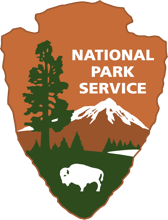by guest author Jennifer Wenger | December 15, 2016
Rena Hatch Fiedler likes to reminisce about her time spent as a child in the Stanford House, a Greek Revival structure just north of the village of Boston in Cuyahoga Valley National Park (CVNP). Every memory is a good one—the farm animals she played with; the abundance of food, expertly prepared by her grandmother; and, perhaps most enjoyable of all, her grandfather, an affable man who joked with her relentlessly. She was welcomed into this world in the front, ground-floor bedroom in 1926, and 20 years later, she and her husband traded wedding vows in the living room, just across the hallway.
That’s a lot of history for one building to lay claim to. For roughly 135 years, the Stanford House and its surrounding farmland played the role of strong, silent provider to the people who lived there, keeping them nourished, grounded, and—for the most part—safe from harm. After the National Park Service purchased the property in 1978, the Stanford House would receive new life, offering a peaceful retreat for travelers, students, and others who wished to develop a more personal bond with the region and its beginnings.
The story of the Stanford House can be pieced together with help from books on the early years of Summit County, oral histories, and historic structure summaries, among other resources. It begins with James Stanford, one of the original settlers to the Cuyahoga Valley. James, who was born in Ireland in 1775, was living in Trumbull County, Ohio, in 1805, the year he signed on with the Connecticut Land Company to help survey a portion of the Connecticut Western Reserve. The following year, he returned to the newly charted territory with his wife and growing family to establish their lifelong home.
Two tales about James Stanford bear retelling. First, he’s credited with giving Boston Township its name by resolving a minor power struggle between two fellow settlers. Whereas Alfred Wolcott liked the sound of Wolcottsburg and Samuel Ewart preferred Ewartsville, Stanford proposed the name of Boston, giving homage to the town in Massachusetts that was so pivotal to America’s roots. (Some historians, after discovering that the Irish township in which James was born was also named Boston, wonder if he might have been secretly honoring his own roots as well.)
The second tale has to do with his sheer luck. Originally, the Stanford property had been located on a swath of high ground in the northeast part of the township, while Alfred Wolcott’s property was located in the valley, on the east side of the Cuyahoga River. When Wolcott’s new bride told her husband that she feared the vapors given off by a nearby swamp were unhealthy and she wished to move, Wolcott asked Stanford to swap properties, and he agreed.
Stanford’s new property proved wonderfully fertile for growing wheat, hay, and other crops, and, as a bonus, it possessed a natural spring. Furthermore, James had no way of knowing then that, in two decades, the Ohio and Erie Canal would be constructed alongside the river, connecting Boston Township to markets in Cleveland, Akron, and points beyond. His neighborly gesture ensured that the Stanfords would become one of the more prosperous families in the region.
James Stanford died at the age of 52 in 1827, the same year in which the first section of the canal opened, and he willed the farm to his eldest son, George. Sixteen years later, in roughly 1843, George would build the stately home on Stanford Road. Over time, he would add several outbuildings, including a barn, smokehouse, springhouse, and granary.
George and his wife Catherine had eight children, though sadly, only one—George Carter (George C.)—outlived his parents. According to Rebecca Jones Macko, a ranger and cultural resources expert in CVNP’s Division of Interpretation, Education and Visitor Services, one son died near the end of the Civil War in Andersonville Prison, Georgia. As for the others, no one knows the causes, although it’s conceivable that disease brought on by the canal could have played a role.
Born in 1839, George C. Stanford is one of the best known of the early Stanfords, thanks to the diary he kept for most of his adult years. George C.’s day-to-day entries offer a glimpse into the life of a farmer-businessman at a time when he and his fellow Bostonians were transitioning from horses and canal boats to the trains that would begin rumbling through the area in 1880. He dabbled in a little bit of everything—from lumber to dairy to hay and corn, to apple cider, and even lightning rods.
George C. was a “less is more” type of journal writer, describing actions over feelings and sometimes leaving out the most important parts.
“At some point, (George) loses a hand to a hay knife in chopping silage for his cattle,” says Jones Macko. “Loses his hand. He continues to keep the diary, but he never mentions losing the hand.”
At age 30, George C. married Lida Wetmore, and together they had three children: Ellen, Perkins, and Clayton. Although Perkins and Clayton would inherit other property, Ellen was the heir of the Stanford House and part of its acreage. (Clayton and his family moved into the granary, which had been converted into a house and pulled—by horses—up the hill next door.) After her father died in 1921, Ellen decided to give the house and land to Earnest Dickinson, a farmer who lived on Stanford Road and whose grandfather was Lida’s brother. Ellen told Dickinson that the property could be his as long as he and his wife Mary would allow Lida and Ellen to live there and be cared for, and they dutifully complied.
Earnest and Mary Dickinson were Rena Fiedler’s grandparents on her mother’s side. In 1954, they sold the property to Roy H. Clark, who sold it to the National Park Service in 1978. From the late 1980s until 2008, the Stanford House was operated as a youth hostel, providing low-cost accommodations to area visitors. After receiving a $300,000 facelift, funded by Conservancy donors and the National Park Service, the Stanford House was reopened in 2011 and is now available for rental by environmental education classes as well as for family reunions, business retreats, and other uses.
Even now, the stories live on.
“To step into the Stanford House is to step back in history,” says Jones Macko. “Yes, the furniture is a little more modern and there’s a modern feel to it. And yet walking through, you can almost hear the echoes of the farm that was there in the past.”
She adds, “George C. lived through tumultuous times. And yet, you can’t see that looking at the house. The house still stands. Things will last long beyond us. Listen to the stories.”
In 2011, the Conservancy led a campaign to restore the Stanford House in keeping with its historic roots. The project funded structural rehabilitation, new furnishings and lighting, fire safety features, and a renovated kitchen. All told, the Conservancy raised $192,500 from 68 generous donors to ensure future generations could experience the history of the Stanford House in their national park.
Today, the Conservancy operates the Stanford House as a rental and educational facility. The historic home and its location along the Towpath and Stanford trails offer a unique “home base” for groups hoping to make an excursion in the national park. Youth groups, photo clubs, school children, or other community groups can rent the entire house year-round.
Learn more about visiting or renting the Stanford House for yourself or a group >





